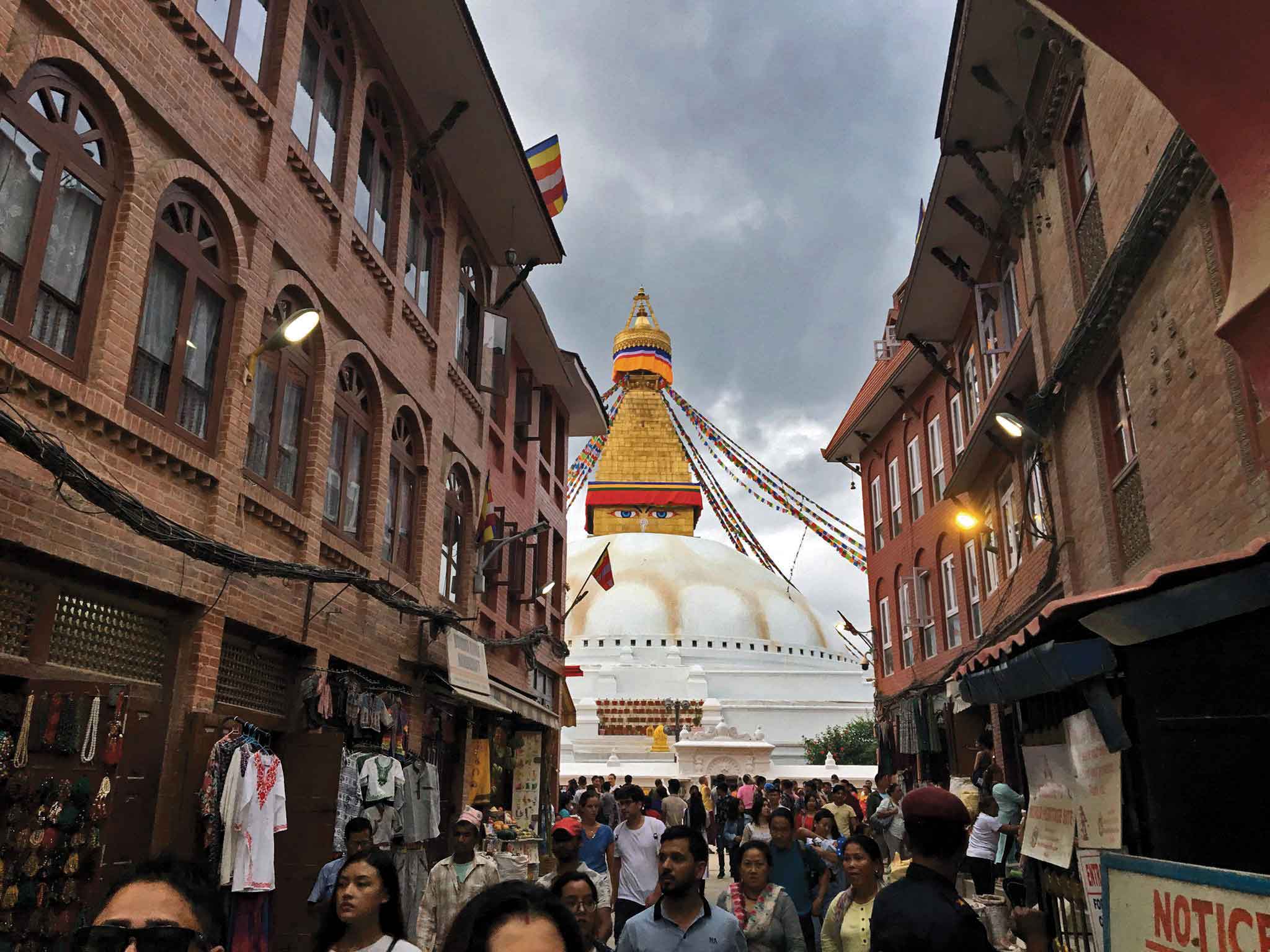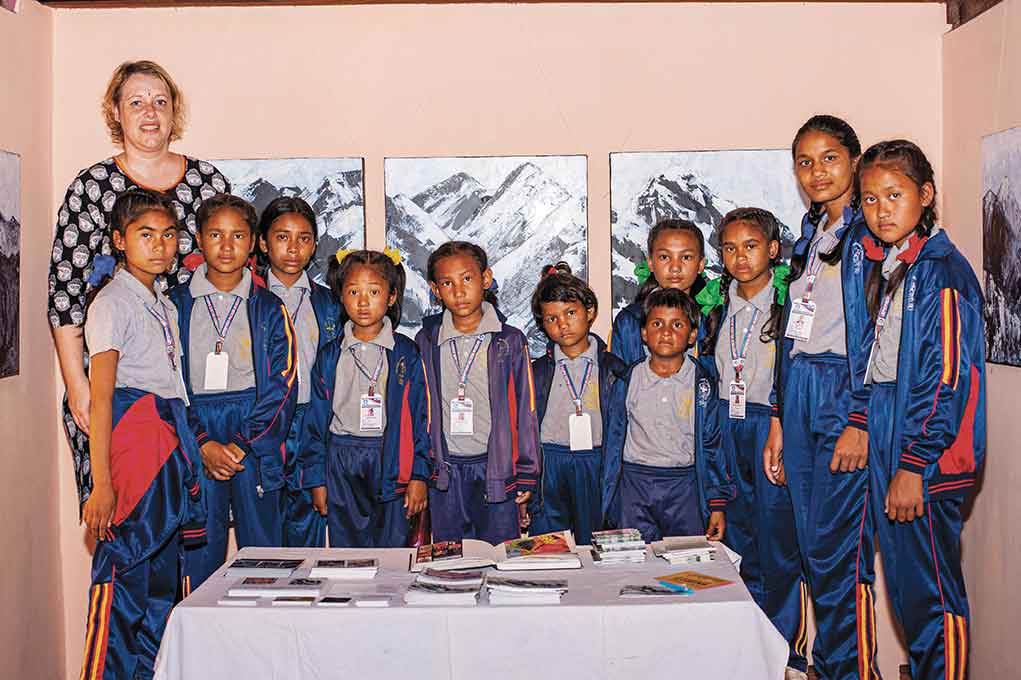Nripa Dhoj Khadka, an amateur photographer has been involved in photography for nearly 30 years but has never held an exhibition. Khadka, a senior instructor of Electronics and Computer Engineering at Pulchowk Campus first came to Kathmandu from Jiri after his SLC exams and has been teaching computers and electronics for 25 years now. But he has another world hidden away, where he comes alive with every fiber of his being. It is the world of wild flowers, insects and birds. From the first time he looked through the camera with curiosity, it started a process that led him to an enchanting world that has not satiated his curiosity till today. Instead it has led to hunger for more moments in photography. In the past, Khadka has shown little interest in earning fame through photography. The only time he took part in a competition was during Wildlife Conservation Nepal photography last January where he emerged as a winner.
 Tell us about your first familiarization with a camera.
Tell us about your first familiarization with a camera.
When I was in class 8, two German tourists came to our school to take some photos. Since they could not speak in English, we communicated through gestures. I looked at them with wonder as they clicked snaps. On impulse I extended my hand to see the device. They left only to return after five minutes and handed me their tiny Pattri German camera. I could not use it as I had no film and after completing my SLC, I came to Kathmandu. After three years I could finally use the camera.
How did Kathmandu provide you with the ground to develop your interest?
As a college student, I think I gained a lot of knowledge in photography just by observing the photos in the magazines for which I visited the British Council and American Library. I made many friends from this field by frequenting photo studios. A friend at Royal Photo Studio shared his technical knowledge with me and even allowed me to watch him work in his lab. As time passed by I went on taking pictures with my Pattri camera with a manual focus. My interest developed but the camera got damaged and I later lost it. Slowly, I collected money to buy a Yashica camera. I used Olympus and Nikon camera as well and now I have settled for the latest Nikon camera.
Since you are not into competitions and exhibitions, why did you participate in WCN competition?
I usually develop my photos at Fujimal in Thamel. After having seen my shots regularly over a period of time, a friend from this studio told me about WCN competition for amateurs. I brought the photos and spread them in front of him to select and he picked three out of the lot and sent them for me. This was the first time I was participating in a competition and I stood first in it. After that I have not participated in any other competition.
Photography for you has been a hobby so far. Tell us about the other dimensions your interest could possibly develop into?
In 1994, when I was in Canada for training, I met a Canadian and showed him my photos. He suggested I collect and compile a book and it was then that I saw the possibility in this direction. Since then I started collecting my photos including the ones taken in Canada. After arriving here I went a little into digital photography. I think I am one of the first users of Digital camera in Nepal. When I used to go to photo studios in new Road, I was told they did not know what a digital camera was.
What kind of photography do you do?
I mainly focus on wild flowers. Among wild flowers also, one of the tiniest. I have a collection and if you measure the diameter of these flowers they are only 3 mm in diameter. If I like, I click pictures of flowers in the garden and of wild plants. I focus on three categories—plants, insects and environment related issues.
Can you tell us more about your environment related pictures?
When Kathmandu valley was flooded a few years back, I took pictures from the university gate to Chobar, of small and big landslides. I collected 33 landslide pictures and even put them in the Internet. I have collections of man-made problems such as that of water being blocked by plastics in the Bagmati. I am a regular at Godavari and exactly at 10 in the morning, blasting is done followed by strong vibration and birds flying away. I have such collections too. I find old temples with interesting trees growing on them or with cracks. I collect pictures of normally overlooked small temples around the big temples. Also, I take lifestyle pictures especially in Khokana, Kirtipur and Bhaktapur.
Which are the places that interest you photographically?
Godavari is my first choice as it is very rich in plants and insects. Other places are Dakshinkali, Nagarjung and Budhanilkantha. During the dry season, instead of Godavari, I go to the temples. And in the rainy season, new kinds of vegetation and insects emerge so then I go to the fields even if the leeches make me bleed. Initially, I used to go to these places alone but gradually I met other like minded people and so these days we go in groups of 4 to 5. Now I have a collection of photos that I have shot alone in a period of 12 to 14 years.
What is your personal underlying principle that gives you satisfaction?
No matter where I go, my principle is that in one visit, if I get one excellent shot, then I have no qualms even if thousands of shots are wasted.
Was there a moment in your life when you did not want to continue with photography?
Once during Dashain I went home carrying my Olympus camera with a zoom lens. I saw an orchid on a tree and while climbing to take the picture I slipped. The camera fell and the lens was damaged and I couldn’t use it again. After my lens was destroyed I felt bad, as I had bought that lens with my hard earned money. After that I stopped photography for nearly two or three months. Although I had stopped, as soon as I saw tourists carrying cameras, I used to feel something from inside and so I continued. At another time I was attacked in Godavari by a robber. Luckily he did not take my camera and equipment, but a certain amount of money. At that time also, I felt disheartened and did not go to Godavari for two weeks.
Can you describe that incident in Godavari?
Six months ago, I was shooting a water drop on a blade of grass. I did feel the presence of a person in the vicinity but Godavari is a place which people frequent so I was not alert. A voice from behind asked, where I had come from and why I was taking pictures. He had a long knife hidden in his full sleeve shirt and commanded me to get up. I was carrying my latest expensive equipment with me. He had a look at the equipment, but I suppose he must have had doubts about selling it and so he told me to take out my purse. Unluckily that day I had a large amount with me. After taking my money he left. More than the robbery on me, I wanted to analyze why our society is degrading. He was a well-dressed healthy looking man. There was no need for him to do this to survive. He could very well work to earn a living. But hazards are part and parcel of working in the field. Sometimes accidents happen and many times unknown insects bite you. You get peculiar allergies and you don’t know why and how it happened.
When do you plan to hold an exhibition? If you were to hold an exhibition, what kind of pictures would you put on display?
Probably a year later! If I hold an exhibition, perhaps you’ll never see the faces of people. We have to understand and realize that as long as you have energy, just go out and take pictures and as you grow older, going to the field becomes difficult, then you do exhibitions. Of course, it is good to do the exhibition immediately, but I do not see the need for it immediately. If I do my exhibition, my first invitation will go to school children because in botany we make figures. Nowadays we can enlarge photos and see in detail how things are built. This will help a child to understand it better.
Is microphotography a very difficult task?
Microphotography is one of the toughest in the field of photography. It is very challenging and it can ruin our backs also as we have to sometimes lie down on the ground and wait for the perfect moment. Even the slightest movement due to wind can result in imperfections. It is not as easy as taking pictures of processions with a wide angle. I have not been able to do much of insect photography because they move. By the time you have worked out a composition, it has already moved to another place. That’s why it is difficult.
As a photographer, what would you like to tell your fellow photographers and our readers?
I would like to request them not to put up an exhibition of poor, suffering people. For example, if one takes a photo of a child on the street with flies all over his nose and face, and gets a prize money of one lakh, we should ask whether that one lakh is the photographer’s or that of the child. Was the money given for my talent, for my equipment or was it for the picture of that child? That’s why I feel it is better if you exhibit other kinds of photographs. But if you exhibit these kinds of photos, then make sure you charge a fee, collect the money and send it to the development of that place or people. My ethics doesn’t allow me to benefit from pictures of such suffering people. Another point I’d like to make is; A photo should carry a lot of meaning and preferably, positive. I see a great need for environment related photography through which we can convince people to care about their surroundings. Polluted vehicles are the main cause of increased pollution. There is need for photographers who will work to bring awareness but unfortunately such photographers are really few in number. We all know that one photograph can speak a thousand words!

Healing Aromas - A Photo Story
“My mother, Maha Laxmi Shrestha makes about 100 packets of incense per day. I help her on dayswhen we have...










